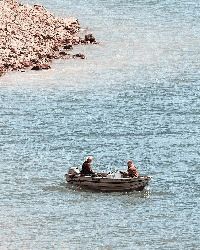Phillips perch problem lacks simple solutions
Published 12:00 am Tuesday, January 8, 2008

- Fishermen trolled Phillips Reservoir in June. The fishery once boasted quality trout fishing, but illegally introduced perch have out-competed trout and now dominate the reservoir. A seven-member committee is studying the problem. (Baker City Herald/Kathy Orr).
By MIKE FERGUSON
Baker City Herald
There are at least four ways to reduce the prodigious perch population in Phillips Reservoir, leaving more tiny nutrients available for the trout most anglers prefer:
n Introduce a predator to chomp the perch
n Poison the reservoir
n Net the unwanted perch, along with undesirable suckers and squawfish
n Plant more and bigger trout each fall and hope they can outcompete the perch, which someone illegally dumped into Phillips about 20 years ago.
If any of those options was easy or economical, the Oregon Department of Fish and Wildlife would have tried it, Tim Bailey, a fish biologist for the agency, told the Baker County Phillips Lake Fishery Improvement Committee Monday.
The committee wants Phillips, 17 miles southwest of Baker City, to return to what it was in the 1970s and early 1980s: one of the region’s premiere trout fisheries.
andquot;People across the Northwest used to brag what a great fishery it was,andquot; said committee member Dewayne Lang, who began fishing Phillips in 1970. andquot;Now you could catch a jillion perch there not big enough to get a fillet off of. The county has lost a lot of revenue from people not coming anymore because it is not a fit fishery.andquot;
andquot;I like catching big trout, and that’s the way it used to be at Phillips,andquot; said committee member Steve Culley. andquot;You can still get fishing like that at Malheur Reservoir and other places, but they’re too crowded.andquot;
Before the committee’s next meeting Feb. 18, Bailey, the regional fish biologist in the ODFW’s La Grande office, pledged to find out what state laws or administrative rules might stand in the way of trying any of the four options.
Committee members, led by Randy Joseph, will explore whether it’s economically viable for commercial companies to net unwanted Phillips Reservoir fish and, perhaps, chop them into fertilizer that area farmers can use.
Joseph, who’s chairing a committee exploring construction of a hydroelectric plant at the base of Mason Dam, said the work of the two committees could intersect. Money that the county doesn’t have to put into constructing fish screens to protect fish from the hydroelectric turbine could be spent boosting the reservoir’s trout count, he said.
Continued from Page 1
Bailey identified issues that could impede some of the perch-purging options. It’s illegal in Oregon, for example, to introduce the tigermuskie, a predator being touted by some anglers for its perch-eating proficiency.
andquot;There are lots of problems using predators,andquot; Bailey said. andquot;It’s not as simple as people make it seem. Each predator has a different habitat, and has preferences for different fish. Perch is not the preferred fish of predators. Think of yourself: Would you rather eat a fish that slides down nice, or is real bony going down?andquot;
Using rotenone to poison the reservoir is expensive and time-consuming, Bailey said: The same process in Diamond Lake in Central Oregon cost $2 million and took 10 years to debate and then do.
In 2004 and 2005, The Idaho Department of Fish and Game removed 300,000 perch from Phillips Reservoir to restock Lake Cascade near McCall.
andquot;The downside to that (approach) is that it’s very labor-intensive,andquot; Bailey said. andquot;That was three weeks working with boats, people and trucks, and that’s way beyond our ability. We could do it using volunteers, but it would still take us three weeks during the spring when we’ve got a lot of other things to do.andquot;
County Commission Chair Fred Warner Jr. said the best approach could involve pieces of two options: Organize a pool of volunteers to net as many perch as possible just before the females spawn, and find money through the Legislature to boost the number of fall trout fingerlings ODFW puts in the reservoir.
For the past few years, ODFW has been planting about 25,000 six-inch-long fall fingerlings, Bailey said. Those fish, which are bigger than the trout ODFW releases in May and better able to hold their own against the perch, grow to legal size the following March.
andquot;We know the May fingerlings can’t compete, but these fingerlings have a better ability to find the food resources they need to grow,andquot; Bailey said.
Warner wants the committee to find a solution sufficiently viable to attract funding from the Legislature. Money to pay for a study could include some netting of perch, he added.
andquot;That fishery is really important,andquot; Warner said. andquot;We want something that’s usable and sustainable without a large dollar outlay and huge environmental impact.andquot;





